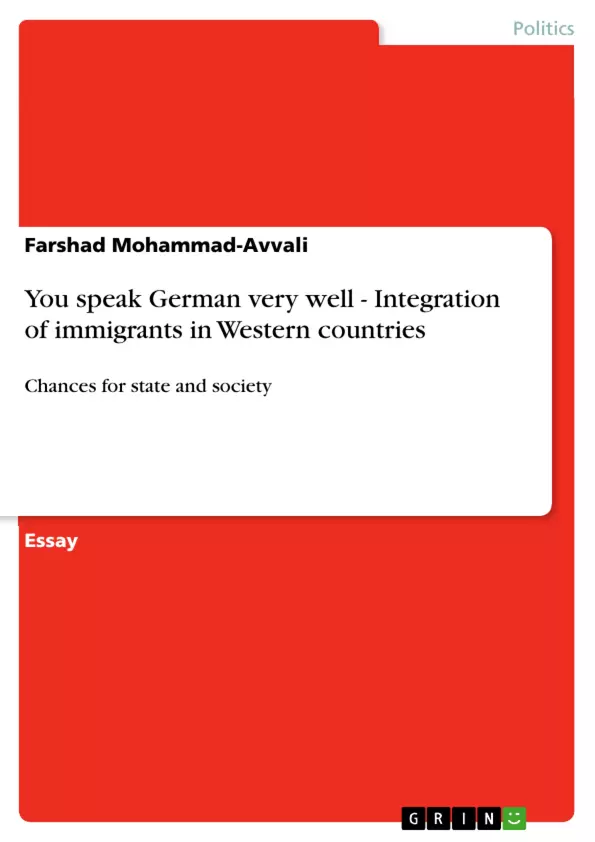The incentive for the topic of integration derived from the personal experience of coping with the forces of integration in Germany and the rise of the matter of integration to a salient part of the domestic agenda of Western European states and the US as well as countries like New Zealand and Australia. Whether the author considers himself as a success story of smooth integration into German society shall not be debated here. With stagnant or even declining birth rates in the above mentioned countries, the inevitable presence of considerably high percentages of immigrants and their children and, probably most importantly, with the international program to promote the unity of the human race , Western politicians, “native” societies and immigrants together must reconsider the principles of integration, national identity and citizenship as indicators of a national community. Surely, this exposes the antagonists of this process to serious challenges and changes. Any idea of blood-and-soil identity cannot be upheld anymore, neither by the host-society nor by any immigrant community, and the legal access to full citizenship must be granted by the state. The transition from “guest” to “citizen” is not impossible nor a horribly difficult adventure; it can be achieved with a deliberate and genuine effort and collaboration by all three important parts of society. Thus, this paper argues that there is indeed a “digestible” form of integration that will rule out the breeding of conflict by availability of positive identification with the host society.
On a general note, in all discussions about integration and identity, one should remember the problem of the “softness” of this phenomenon. A widespread problem for any field of humanities is that we cannot hold our research objects in our hands. By trying to do so, we materialize them in language, spoken or typed, and hence, force it into boundaries that deform its natural state of being in society. The intricate encounters in daily discussions which form public opinion about integration and immigration cannot be handled here. We should just be aware that there are influential forces within society that dominate a certain type of thinking, no matter positive or negative towards integration of immigrants. To filter out which phenomena contribute to which attitude is not the goal of this paper .
Inhaltsverzeichnis (Table of Contents)
- Introduction
- Reviewing Nationalism and Identity
- Integration, Separation, Assimilation
- Conflicts over differences
- Who is responsible for integration?
- Conclusion
Zielsetzung und Themenschwerpunkte (Objectives and Key Themes)
This paper aims to explore the complexities of integrating immigrants into Western societies, focusing on the evolving definitions of national identity and citizenship in the face of increasing immigration. It examines the historical and contemporary struggles of integrating immigrants into the host societies, analyzing the role of state policy, societal attitudes, and the individual experiences of immigrants themselves. This analysis seeks to understand the factors contributing to successful integration, while also highlighting the challenges and conflicts that may arise.
- The changing nature of national identity in Western societies
- The role of state policy and legislation in promoting integration
- The influence of societal attitudes and perceptions on integration
- The challenges of navigating cultural differences and achieving a sense of belonging
- The concept of "digestible" integration as a means of promoting peaceful coexistence
Zusammenfassung der Kapitel (Chapter Summaries)
- Introduction: This chapter introduces the topic of integration, outlining the growing importance of the issue in Western societies. It emphasizes the need for a reassessment of integration principles, national identity, and citizenship in the context of immigration. The author argues for a "digestible" form of integration that promotes positive identification with the host society.
- Reviewing Nationalism and Identity: This chapter explores the historical development of nationalism and identity, examining the debates surrounding inclusion and exclusion in the context of citizenship and political power. It analyzes the evolution of American identity, tracing the shifting attitudes towards immigration and the influence of economic conditions on the integration process. The chapter also discusses the French and German models of nation-building and their implications for immigrant integration.
- Integration, Separation, Assimilation: This chapter delves into the various models and approaches to immigrant integration, contrasting ideas of assimilation, separation, and a more inclusive approach. It analyzes the challenges of managing cultural differences and the role of societal attitudes in shaping integration outcomes.
- Conflicts over Differences: This chapter focuses on the potential sources of conflict arising from cultural differences and the challenges of achieving a shared understanding between immigrant communities and the host society. It examines the role of language, religion, and societal values in fostering both integration and conflict.
- Who is responsible for integration?: This chapter analyzes the roles and responsibilities of the state, the host society, and immigrants themselves in promoting successful integration. It explores the importance of mutual understanding, cooperation, and shared efforts in bridging the gap between different cultures.
Schlüsselwörter (Keywords)
Key terms and concepts central to the paper include: integration, national identity, citizenship, immigration, multiculturalism, assimilation, separation, cultural difference, societal attitudes, state policy, and conflict resolution. These terms represent the focal points of the analysis, encompassing the historical and contemporary challenges of integrating immigrants into Western societies.
- Citation du texte
- Farshad Mohammad-Avvali (Auteur), 2005, You speak German very well - Integration of immigrants in Western countries, Munich, GRIN Verlag, https://www.grin.com/document/59639



